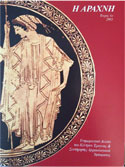JUNE'S WORD: POIKILOS

It is perhaps the most common term used to describe decorated objects, in particular textiles.
Especially for textiles, it refers to colourfully elaborate and decorated objects with woven or embroidered designs, textiles of high quality and rich decoration with many adornments (antonym ὁμόχρους).
Examples: ἱμάτιον ποικίλον πᾱσιν ἄνθεσιν πεποικιλμένον, Pl., Plt. 8.557c; ποικίλη, χρώμασι διειλημμένη, Phr. 110b; ποικίλα ὲσθήματα, Aesch. Pers. 836; κιθῶνες Hrd., 7.61; πέπλος in particular, Il. 5.735, 8.386 etc.; ἱμάς 14.215; φᾶρος Soph. Fr. 586; ἐν ποικίλοις… κάλλεσιν βαίνειν, of a rich carpet, Aesch. Ag. 923; ποικίλα, τά, ibid. 926, 936; Theocr. 15.78· π., τό, for an embroidered esthēs, Crat. 38; ἐπίβλημα π. IG 12.387.28; for Cypriot, Carthaginian and Sicilian fabrics, Arist. Fr. 611, Hermipp. 63.23, Philem. 76.4. Adverb -λως, ὑφασμένον Antiph. 99; στρωμναὶ π. διηνθισμέναι LXX Es. 1.6.
Also of tattoos: ποικίλους δὲ τὰ νῶτα καὶ τὰ ἔμπροσθεν πάντα ἐστιγμένους ἀνθέμια, Xen. An. 5.4.32.
Of metal work: richly produced, decorated ἀμφὶ δὲ πᾱσιν τεύχεα ποικίλ' ἔλαμπε, Il. 4.432, of a cuirass 16.134.
Metaphorically: changefull, diversified, manifold.
Ἡ ποικίλη στοά, or only ἡ ποικίλη, Athenian portico decorated with wall paintings mostly by Polygnotus, e.g. Dem. 45, 17.
Etymology: The verb in the present with double /l/ ποικίλ-jω > ποικίλλω with assimilation of the j. Its root is *ποικ- < *poik-o, as in other similar Indoeuropean terms, from primary verbal root *p(e)ik-, to pierce, mark, speckle, see Lat. pingo.
Already since the Mycenean period po-ki-ro-ko = ποίκιλοψ, po-ki-ro-nu-ka= ποικιλόνυχα “with coloured nails”.
There is a great number of composita and derivatives, among which most interesting for us: ποικιλανθής, ποικιλόστικτος, ποικιλόχρωμος, ποικιλόβαπτος, ποικιλοτέχνης, ποικιλουργός, ποικιλόχρως, πολυποίκιλος etc. Also περιποίκιλος, μεσοποίκιλος, refer to patterns at specific places on the fabric (edges, centre), while the terms πολυποίκιλος, παμποίκιλος, μεστὸς ποικιλμάτων (richly and colourfully patterned) refer to a high degree of decoration.
Ποικίλλω, to work in various colours, in particular by weaving, to decorate, to ornate; ποικιλία, ποίκιλμα, ποίκιλσις, woven, embroidered decoration, or any rich decoration; ποικιλτής, ποικίλτρια, craftsperson responsible for textile embellishment.
The term seems to refer to the final optical result, a very richly decorated piece (of fabric), and not to a specific decorative technique (embroidery, tapestry etc.).


